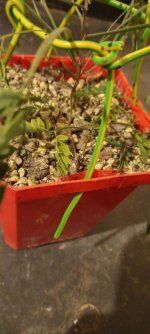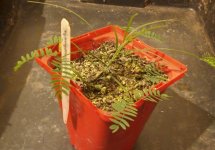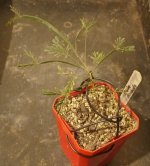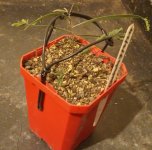I actually have some material from the parent tree so it may end up getting run through some kind of analysis, especially in light of the current method development I've been working on. It will be nice to see how it compares with that of its offspring, since the growing conditions are going to be rather different.Thank you! Yeah no customs issues.. was a 5 min drive up the road
And it’s my pleasure, if you have any more questions don’t hesitate to ask! Look forward to seeing your progress. Will you test it for alkaloids one day? It’s a very promising species retinodes..
-
Members of the previous forum can retrieve their temporary password here, (login and check your PM).
You are using an out of date browser. It may not display this or other websites correctly.
You should upgrade or use an alternative browser.
You should upgrade or use an alternative browser.
Botany The Acacia Grow Thread
- Thread starter acacian
- Start date
Growing logs with advice and results.
Migrated topic.
Phyllode_Pickler
Esteemed member
It's considered a cold snap when we hit -4 to -5 the worst I've seen in my life time is -8. Most frosts here are -1 to -3 and are gone by 8/9 am winter temp day avg is 15°COk cool.. you shouldn’t have any problems growing narrow phyllode in your area.. during the seedling stage I would keep them in a greenhouse for winter if possible. Next winter they should be established enough. Do you get heavy frosts?
Hardening my plants before the first frost hits. Moving into my own home finally so will be putting some in the ground. I’m aware winter isn’t the best time to put plants in the ground, however, since I have so many plants it will at the very least let me know if it was the right move or not. I won’t put any in the ground that I haven’t grown a lot of.
Below some shots of their final days before finding a new home. Also a couple shots of a few NP acuminata which are 6 months old and some Acacia granitica which are a bit over a year old. Acuminata definitely are slower growers than most of my other plants. Once in the ground they should really take off though.
I plan on planting them in the ground in September /
@acacian - thanks for the grow tips you posted a few days back! I had a little peek at my seeds today and saw that at least two of them have sprouted! 
I got 20 out of 24 to swell up with the sandpaper technique, so I'm pretty stoked about this. I also did a little experimentation and found that between 5 and 8 gentle scrapes with 120 grit emery paper on both of the long edges and the far tip (away from the hilum) made for the most successful chances of rapid rehydration.
Time to get that gritty compost mixed, and I hope to be able to contribute a few nice pics over the coming weeks.
I got 20 out of 24 to swell up with the sandpaper technique, so I'm pretty stoked about this. I also did a little experimentation and found that between 5 and 8 gentle scrapes with 120 grit emery paper on both of the long edges and the far tip (away from the hilum) made for the most successful chances of rapid rehydration.
Time to get that gritty compost mixed, and I hope to be able to contribute a few nice pics over the coming weeks.
Phyllode_Pickler
Esteemed member
Hopefully this round of pictures is easier to see than the last lot. There is a very distinct difference between the acuminata and the floribunda now.
Still have the two that just popped from the native soil in with an acuminata, I'll be looking at up potting them soon as I started seeing root tips a week or two ago. When I up put them I'll see if I can save the two that came along for the ride.
Still have the two that just popped from the native soil in with an acuminata, I'll be looking at up potting them soon as I started seeing root tips a week or two ago. When I up put them I'll see if I can save the two that came along for the ride.
Attachments
BTW, it was very clear from the swelling of the seeds alone that they were ready to be placed in dark germination conditions - the lightening of the seed coat was noticeable only upon close inspection in the case of these probable retinodes seeds.
One of the other zillion things I ought to be getting on with is characterising the phyllode biochemistry - I do rather wish I'd stripped the branch and twig bark at the time of pruning as well but that was, sadly, impractical at the time.
One of the other zillion things I ought to be getting on with is characterising the phyllode biochemistry - I do rather wish I'd stripped the branch and twig bark at the time of pruning as well but that was, sadly, impractical at the time.
@Transform yeah different seeds will behave differently.. not all have such an obvious colour change. Hope they germ!
That would be really cool to see more info on.. I suspect it will lead to also understanding common chemical profiles in alkaloid bearing species.. and even their correlation to different taxonomic traits.
That would be really cool to see more info on.. I suspect it will lead to also understanding common chemical profiles in alkaloid bearing species.. and even their correlation to different taxonomic traits.
Yeah your acuminata are getting the more terete shape to the phyllodes. They’ll continue on that trajectory for a little while and then will flatten out again as it gets older!Hopefully this round of pictures is easier to see than the last lot. There is a very distinct difference between the acuminata and the floribunda now.
Still have the two that just popped from the native soil in with an acuminata, I'll be looking at up potting them soon as I started seeing root tips a week or two ago. When I up put them I'll see if I can save the two that came along for the ride.
Also.. don’t worry too much about seeing tips of roots at the bottom.. the tap root is first to get down there and will often give you the impression that it needs to be repotted earlier than it does. Obviously having it in bigger pots will help anyways, however transplanting when too young means the roots won’t have bound with the soil yet and you can run the risk of damaging them when transplanting.. they don’t look at all at the point of needing to be transplanted IMO.. even 2 weeks after sprouting a seed can have a tap root almost 3 inches long..
The amount of times I’ve seen roots sticking out the bottom and transplanted only to find the roots are barely developed outwards..
Last edited:
Had another little peep today and most of the 20 successfully soaked seeds start showing signs of sprouting. Because of an unexpected meeting, preparing the grit and perlite got postponed again, but there will be some photos coming up very soon!@Transform yeah different seeds will behave differently.. not all have such an obvious colour change. Hope they germ!
That would be really cool to see more info on.. I suspect it will lead to also understanding common chemical profiles in alkaloid bearing species.. and even their correlation to different taxonomic traits.

As promised:Had another little peep today and most of the 20 successfully soaked seeds start showing signs of sprouting. Because of an unexpected meeting, preparing the grit and perlite got postponed again, but there will be some photos coming up very soon!
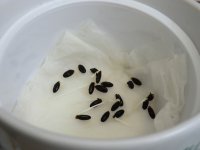
That's about a dozen out of twenty so I'll be hoping that a few more sprout when the weather warms back up.
Awesome @Transform !
I’m sure your aware of this, but you’ll want to get those ones with the longer taproots in pretty soon.. or at least a great deal of care will need to be taken orienting them down in the mix without snapping them when you do. Looking good though.
I’m sure your aware of this, but you’ll want to get those ones with the longer taproots in pretty soon.. or at least a great deal of care will need to be taken orienting them down in the mix without snapping them when you do. Looking good though.
Thanks for the nudge - I'll get down to it ASAP. Fortunately, I'm pretty good with handling fragile plants as well, but that's no excuse for further dawdling! Also, temperatures have tailed off a bit the last couple of nights, maybe that'll keep things from progressing too quickly?Awesome @Transform !
I’m sure your aware of this, but you’ll want to get those ones with the longer taproots in pretty soon.. or at least a great deal of care will need to be taken orienting them down in the mix without snapping them. Looking good though.
Any ideas about the slow germinators? Normal variation/levels of inviability?
Cool temp will maybe slow things, but I'm hearing permission to dawdle further so can't sign off on that one! And I think once they sprout they'll move pretty quickly. Anyways.. if dawdle is a must.. make sure you don't let the tap roots dry out and maybe swap for fresh damp paper towel so they don't go mouldy. A chop stick is a good tool for poking deep holes for long tails.. that sounded poeticThanks for the nudge - I'll get down to it ASAP. Fortunately, I'm pretty good with handling fragile plants as well, but that's no excuse for further dawdling! Also, temperatures have tailed off a bit the last couple of nights, maybe that'll keep things from progressing too quickly?
Any ideas about the slow germinators? Normal variation/levels of inviability?

I've cunningly set things up using very clean water from the start, plus a piece of felt as a filter to allow a tiny bit of FAE without drying out to much. But, I promise you, I will be getting on with it. This one now has top priority!Cool temp will maybe slow things, but I'm hearing permission to dawdle further so can't sign off on that one! And I think once they sprout they'll move pretty quickly. Anyways.. if dawdle is a must.. make sure you don't let the tap roots dry out and maybe swap for fresh damp paper towel so they don't go mouldy. A chop stick is a good tool for poking deep holes for long tails.. that sounded poetic
They are going in now (well, as soon as I've mixed the compost, for which I just logged in to double-check the formula)!
I'll attempt to get some photos of the process.
I'll attempt to get some photos of the process.
What mix will you be moving forward with @Transform .. by grit did you mean sand?
Yes, sand - I also need to discuss the distinction between small grit and coarse sand since I've had to screen my own from a silty, gritty mixture of well-weathered building sand. Yes, I am probably insane. Or should that read "provably"?What mix will you be moving forward with @Transform .. by grit did you mean sand?
OK, I got enough coarse sand together (on consultation of my esteemed missus, she confirmed which fraction looked best) and the thirteen seeds that sprouted out of nineteen which had swelled have now been planted in the 65:25:5 sand erlite:coir mix. Photo story to follow.
erlite:coir mix. Photo story to follow.
EDIT: I've just realised I got the perlite and coir amounts mixed up
And to think, I not only double-checked, but also thought "that doesn't seem like much coir" I guess I'm too accustomed to cactus gardening and high-mineral substrates and just shrugged it off, thinking acacias must prefer low-organic compost, especially since my first acacia grow failed due to using compost with way too much organic content.
I guess I'm too accustomed to cactus gardening and high-mineral substrates and just shrugged it off, thinking acacias must prefer low-organic compost, especially since my first acacia grow failed due to using compost with way too much organic content.
EDIT: I've just realised I got the perlite and coir amounts mixed up

And to think, I not only double-checked, but also thought "that doesn't seem like much coir"
Last edited:
Aaaand... the promised photos!
Mixing the substrate, as per @acacian's recommendation:
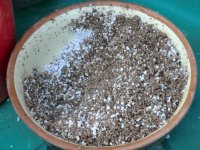
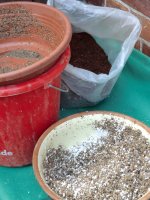
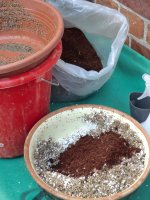
A small planter, with a layer of gravel added for drainage at the base, will be the seedlings' new home while they develop their first leaves/phyllodes:

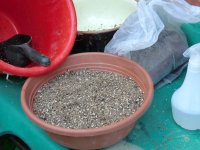
Getting ready to plant the sprouted seeds:
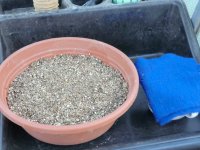
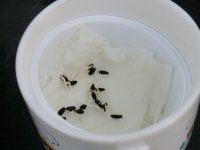
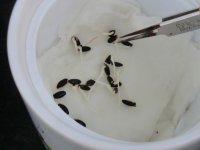
A thin coffee stirrer is a handy implement, as are the precision tweezers:
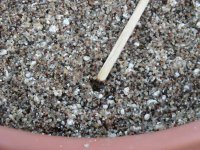

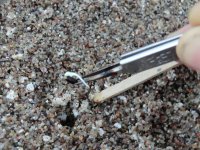
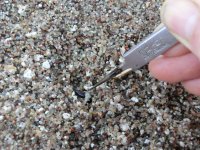
Gently does it - the long roots will be fragile!:

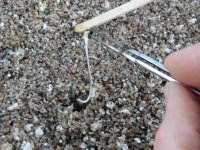
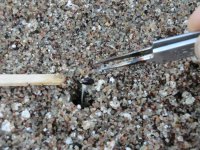
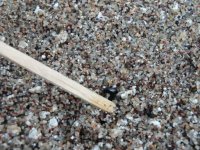
Firming down @pantostao's late doggo's memorial seedling's substrate :
:
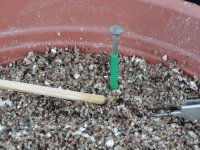
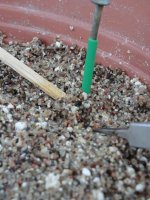
All planted, with the memorial plantlet sat in position 7 at the top of a 13-seed crescent:
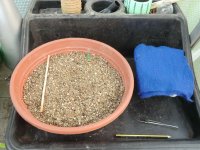
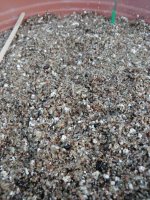
Cosily under a microwave plate cover, which by pure coincidence fits the planter perfectly:
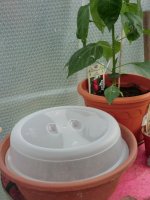
I checked again today - three more of the soaked seeds have begin to sprout, so they'll be joining their siblings soon enough.
Mixing the substrate, as per @acacian's recommendation:



A small planter, with a layer of gravel added for drainage at the base, will be the seedlings' new home while they develop their first leaves/phyllodes:


Getting ready to plant the sprouted seeds:



A thin coffee stirrer is a handy implement, as are the precision tweezers:




Gently does it - the long roots will be fragile!:




Firming down @pantostao's late doggo's memorial seedling's substrate


All planted, with the memorial plantlet sat in position 7 at the top of a 13-seed crescent:


Cosily under a microwave plate cover, which by pure coincidence fits the planter perfectly:

I checked again today - three more of the soaked seeds have begin to sprout, so they'll be joining their siblings soon enough.
This makes me wonder if the germinating seeds produce a germination inhibitor, which slowed the other seeds up to this point, or if it was simply a case of some of the seeds taking a day or two longer to swell becauuse of differences in the degree of scarification, as well as natural variations in the seed coat thickness.I checked again today - three more of the soaked seeds have begin to sprout, so they'll be joining their siblings soon enough.
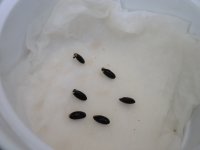
Just a couple more pics, with the tooth picks showing the seed positions more clearly, and the first 'growth update' of the memorial acacia
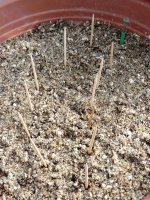
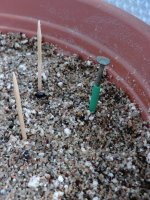 :
:Great work @Transform !
I’m impressed you went to such effort to sift the fine sand out.. attention to fine details like that really will make a difference in the seedling’s early development, which will ensure it gets to as mature a stage as possible before the next winter.. you really want them to pump out as much growth as possible before those cold UK temps set in..
Interesting idea about germination inhibition.. I’m not sure why they germinate erratically.. but it’s pretty normal with a lot of Acacia seeds and can take anywhere from 48 hrs to a few weeks.. if they take too long you can let them dry and then just sow them into your medium and water it to swell them again.. maybe a little less likely to rot that way. Some native nurseries use this approach. I also forgot to mention, any seeds that float to the surface are likely not viable. No harm in leaving them in of course but you should count the floaters so that you have an idea of your germination rate.
You might find interesting this research paper on Acacia seed germination from Cambridge university, which says:
In my experience most seeds if healthy will germinate within the week with the wet towel method.. sowing directly can be much more erratic and take some time/really require the right temperature (around 23 degrees Celsius) . Seeds from different species can behave quite differently so trial and error is usually in order. For example I have a tray of Acacia phlebophylla seeds I sowed about 7 months ago.. I sowed about 40 seeds and they only stopped sprouting a few weeks ago as the temperature dropped. About 25 of the 40 have sprouted and seem like they’ll continue once it gets warmer again if I’m diligent in keeping the medium moist. During late summer and early autumn about 3 or 4 seeds germinated each week. Some species just seem harder to bring out of dormancy. In the wild it is often bushfire that damages the coat and the rainfall afterwards causes the swell and brings them out of dormancy. Thicker seeds can respond poorly to boiling water treatment if using damp towel method.. and do better with nicking and cold water I find.
Oh and before I forget.. very important with native a lot of Australian plants to avoid too much phosphorous in your mix.. especially Acacias. Be sure to check any fertilizers used are low phosphorous and nitrogen rich. Acacia are nitrogen lovers
Scotts Osmocote Native Fertilizer is a good brand of native Australian plant fertilizer. You should be able to order it online. When you transplant your seedlings into new pots, watering them in with diluted Seasol will help with establishing healthy roots. Lastly, Acacia seedlings do well in taller tubes as the tap root grows fast.. my understanding is that in early stages, tall is more important than wide in the seedling stage IMO. I use 65mm x 65mm x 160mm forestry tubes for seedlings now and you can wait much longer before needing to transplant.
Hope that was easy enough to understand.. been a long day.
On the note of my own plants, they're all out of the greenhouse and in the garden hardening in the elements. We had our first frost the other day but my place is pretty sheltered from the extreme in the lower parts. So its giving them the chance to gradually harden instead of just being suddenly slapped by heavy frost. If it gets too cold I always have a sun room.. they can keep my salvia and Acacia simplex company.
Couldn’t resist sharing some photos and video of the wattles at night with the dew floating around them.. notice in photos 1, 2 and 10 how red the maidenii are going red from the cold. They should survive as they are the most established of my plants, and they are survivors from last winter when they were a mere 3-4 inches tall.
Photos in order:
1 and 2 - Acacia maidenii
3 and 4 - Acacia acuminata narrow phyllode var.
5. Acacia obtusifolia and phlebophylla saplings
6. Either Acacia retinodes or provincialis.. it was accidentally included in a seed packet with some floribunda seed. I also have some retinodes seed so will sow some in spring to compare to this specimen.
7. Acacia courtii
8. Acacia floribunda 'white willow'
9. Acacia phlebophylla
10. Acacia maidenii
11 and 12 - Acacia phlebophylla
I’m impressed you went to such effort to sift the fine sand out.. attention to fine details like that really will make a difference in the seedling’s early development, which will ensure it gets to as mature a stage as possible before the next winter.. you really want them to pump out as much growth as possible before those cold UK temps set in..
Interesting idea about germination inhibition.. I’m not sure why they germinate erratically.. but it’s pretty normal with a lot of Acacia seeds and can take anywhere from 48 hrs to a few weeks.. if they take too long you can let them dry and then just sow them into your medium and water it to swell them again.. maybe a little less likely to rot that way. Some native nurseries use this approach. I also forgot to mention, any seeds that float to the surface are likely not viable. No harm in leaving them in of course but you should count the floaters so that you have an idea of your germination rate.
You might find interesting this research paper on Acacia seed germination from Cambridge university, which says:
The seeds of most Australian acacias have pronounced physical dormancy (PY). While fire and hot water (HW) treatments cause the lens to ‘pop’ almost instantaneously, for many Acacia species the increase in germination percentage can be gradual. If PY is broken instantly by HW treatment, why is germination often an extended process? Control and HW treatments were performed on seeds of 48 species of Acacia. Seeds were placed on a moist substrate and imbibition was assessed by frequently weighing individual seeds. In the two soft-seeded species all control seeds were fully imbibed within 6–24 h, while in hard-seeded species very few control seeds imbibed over several weeks. In 10 species over 50% of the HW-treated seeds imbibed within 30 h, but mostly the percentage of imbibed seeds gradually increased over several weeks. Some seeds in a replicate would imbibe early, while others would remain unimbibed for many days or weeks then, remarkably, become fully imbibed in less than 24 h. While HW treatment broke PY almost instantaneously, it appeared that in many Acacia species some other part of the testa slowed water from reaching the embryo. This process of having staggered imbibition may be a way of ensuring not all seeds in a population germinate after small rain events. Thus it appears the lens acts as a ‘fire gauge’ while some other part of the seed coat acts as a ‘rain gauge’.
In my experience most seeds if healthy will germinate within the week with the wet towel method.. sowing directly can be much more erratic and take some time/really require the right temperature (around 23 degrees Celsius) . Seeds from different species can behave quite differently so trial and error is usually in order. For example I have a tray of Acacia phlebophylla seeds I sowed about 7 months ago.. I sowed about 40 seeds and they only stopped sprouting a few weeks ago as the temperature dropped. About 25 of the 40 have sprouted and seem like they’ll continue once it gets warmer again if I’m diligent in keeping the medium moist. During late summer and early autumn about 3 or 4 seeds germinated each week. Some species just seem harder to bring out of dormancy. In the wild it is often bushfire that damages the coat and the rainfall afterwards causes the swell and brings them out of dormancy. Thicker seeds can respond poorly to boiling water treatment if using damp towel method.. and do better with nicking and cold water I find.
Oh and before I forget.. very important with native a lot of Australian plants to avoid too much phosphorous in your mix.. especially Acacias. Be sure to check any fertilizers used are low phosphorous and nitrogen rich. Acacia are nitrogen lovers
Scotts Osmocote Native Fertilizer is a good brand of native Australian plant fertilizer. You should be able to order it online. When you transplant your seedlings into new pots, watering them in with diluted Seasol will help with establishing healthy roots. Lastly, Acacia seedlings do well in taller tubes as the tap root grows fast.. my understanding is that in early stages, tall is more important than wide in the seedling stage IMO. I use 65mm x 65mm x 160mm forestry tubes for seedlings now and you can wait much longer before needing to transplant.
Hope that was easy enough to understand.. been a long day.
On the note of my own plants, they're all out of the greenhouse and in the garden hardening in the elements. We had our first frost the other day but my place is pretty sheltered from the extreme in the lower parts. So its giving them the chance to gradually harden instead of just being suddenly slapped by heavy frost. If it gets too cold I always have a sun room.. they can keep my salvia and Acacia simplex company.
Couldn’t resist sharing some photos and video of the wattles at night with the dew floating around them.. notice in photos 1, 2 and 10 how red the maidenii are going red from the cold. They should survive as they are the most established of my plants, and they are survivors from last winter when they were a mere 3-4 inches tall.
Photos in order:
1 and 2 - Acacia maidenii
3 and 4 - Acacia acuminata narrow phyllode var.
5. Acacia obtusifolia and phlebophylla saplings
6. Either Acacia retinodes or provincialis.. it was accidentally included in a seed packet with some floribunda seed. I also have some retinodes seed so will sow some in spring to compare to this specimen.
7. Acacia courtii
8. Acacia floribunda 'white willow'
9. Acacia phlebophylla
10. Acacia maidenii
11 and 12 - Acacia phlebophylla
Attachments
-
 IMG_7471.jpeg766.1 KB · Views: 6
IMG_7471.jpeg766.1 KB · Views: 6 -
 IMG_7472.jpeg890.8 KB · Views: 8
IMG_7472.jpeg890.8 KB · Views: 8 -
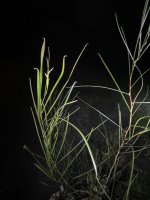 IMG_7464.jpeg1,004.8 KB · Views: 8
IMG_7464.jpeg1,004.8 KB · Views: 8 -
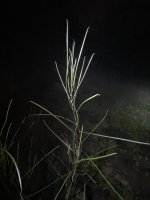 IMG_7463.jpeg943.2 KB · Views: 9
IMG_7463.jpeg943.2 KB · Views: 9 -
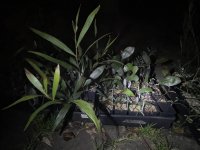 IMG_7466.jpeg1.7 MB · Views: 10
IMG_7466.jpeg1.7 MB · Views: 10 -
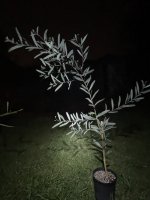 IMG_7459.jpeg1,008.6 KB · Views: 6
IMG_7459.jpeg1,008.6 KB · Views: 6 -
 IMG_7451.jpeg1.8 MB · Views: 7
IMG_7451.jpeg1.8 MB · Views: 7 -
 IMG_7445.jpeg1.9 MB · Views: 7
IMG_7445.jpeg1.9 MB · Views: 7 -
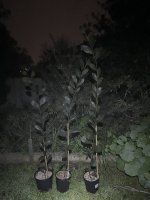 IMG_7443.jpeg1.4 MB · Views: 5
IMG_7443.jpeg1.4 MB · Views: 5 -
 IMG_7470.jpeg993.1 KB · Views: 5
IMG_7470.jpeg993.1 KB · Views: 5 -
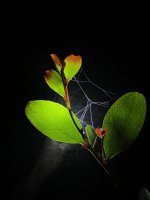 IMG_7482.jpeg1 MB · Views: 7
IMG_7482.jpeg1 MB · Views: 7 -
IMG_7485.mov181.7 MB
Last edited:


